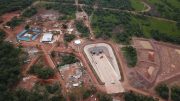The Northern Miner has compiled a list of the top-10 diamond companies with headquarters in Canada, ordered by market capitalization, as of early July 2019.
1. Lucara Diamond
Market cap: $623 million
Lucara Diamond (TSX: LUC) is part of the Lundin Group of companies and owns the Karowe diamond mine, in Botswana, which has produced since 2012, and is one of the world’s foremost producers of large, high-quality, Type IIA diamonds in excess of 10.8 carats. These include the historic 1,109-carat Lesedi La Rona (the second-largest gem diamond ever recovered), and the 813-carat Constellation, which was sold for a record US$63.1 million. Since starting production, the company has sold 180 diamonds for more than $1 million each, and 10 single diamonds for more than $10 million apiece.
The company has paid out more than US$249 million in dividends, which exceeds the total capital invested to build the mine. The company is advancing its Clara digital diamond sales platform, which it acquired last year. Lucara held its inaugural sale on Clara in late 2018, and two sales of rough diamonds totalling $1.4 million were completed in the first quarter of this year. Clara sells rough diamonds individually and Lucara envisions that other diamond producers will want to sell diamonds on the digital platform, which uses computing algorithms to match rough diamond production to buyers who want stones with the same characteristics. The company recorded net income of $11.7 million, or 3¢ per share in 2018, which was a record year for the recovery of specials — single diamonds in excess of 10.8 carats — with 829 stones totalling 24,793 carats recovered, including 33 diamonds in excess of 100 carats, of which five stones exceeded 300 carats.
2. Mountain Province Diamonds
Market cap: $269 million
Mountain Province Diamonds (TSX: MPVD; NASDAQ: MPVD), in a joint venture with De Beers, operates Gahcho Kué, the world’s largest new diamond mine. The mine in Canada’s Northwest Territories is projected to produce an average of 4.5 million carats a year on a 100% basis over an initial 12-year mine life, with production in the first five years (2017–2021) expected to average 5.4 million carats a year.

Machines at Mountain Province Diamonds and De Beers’ Gahcho Kué diamond mine in the Northwest Territories. Credit: Mountain Province Diamonds.
Mountain Province also owns the Kennady North project, which it acquired last year from Kennady Diamonds. The project is next to Gahcho Kué and consists of the Kelvin kimberlite and the Faraday kimberlites. Last year at Kennady North, Mountain Province focused on establishing an inferred resource for the Faraday 2 kimberlite along its full length. According to a resource update in February 2019, Faraday 2 has a total inferred resource of 2.07 million tonnes at an average grade of 2.63 carats per tonne totalling 5.45 million carats at an average diamond value of US$140 per carat. The Faraday 3 Lobe has an inferred resource of 1.87 million tonnes grading 1.04 carat per tonne totalling 1.90 million carats at an average diamond value of US$75 per carat. The Kelvin kimberlite has an indicated resource of 8.5 million tonnes at an average grade of 1.60 carats per tonne totalling 13.62 million carats at an average diamond value of US$63 per carat.
3. Star Diamond
Market cap: $88 million
Star Diamond’s (TSX: DIAM) Star-Orion diamond project in the Fort à la Corne diamond district of central Saskatchewan, received approval under the province’s Environmental Assessment Act in October 2018. A preliminary economic assessment of the Star and Orion South kimberlites, estimates a 34-year mine life producing 66 million carats. The early stage study outlines an after-tax net present value at a 7% discount rate, 19% post-tax internal rate of return, and a 3.4-year payback, after the start of commercial production. Pre-production capex is pegged at $1.41 billion. The project is 60 km east of Prince Albert.

The first of 10 holes Rio Tinto is drilling at Star Diamond’s Star-Orion South diamond project in Saskatchewan using a Bauer trench cutter rig. Credit: Rio Tinto.
Rio Tinto Exploration Canada (RTEC), a wholly owned subsidiary of Rio Tinto, has an option to earn up to a 60% interest in the company’s Fort à la Corne mineral properties, which include the Star-Orion project. RTEC drilled the first bulk-sample hole on the Star kimberlite in June, and a 90-person, on-site camp has recently been expanded to accommodate up to 150 people.
4. Archon Minerals
Market cap: $27 million
Archon Minerals (TSXV: ACS) is headed by legendary mine finder Stewart Blusson, who, with Chuck Fipke, found Canada’s first economic diamond deposit in the Northwest Territories near Lac de Gras, now known as the Ekati diamond mine. The company is focused on the Northwest Territories and has a gross production royalty equal to 2.3% of the gross value of diamonds produced from the Buffer zone at the Ekati mine.
The Buffer zone contains the Lynx pipe, which started commercial production as an open pit in 2017, and the Jay pipe. Archon also owns 100% of the 809.4 sq. km of mineral leases that were formerly part of the Western Buffer Zone, as well as interests in other diamond properties in the area.
5. Stornoway Diamond
Market cap: $23 million
Stornoway Diamond (TSX: SWY; US-OTC: SWYDF) is one of the few juniors to have put a diamond mine into production. In early 2017, the company’s wholly owned Renard mine achieved commercial production in Quebec’s James Bay region, 350 km north of Chibougamau.

Stornoway Diamond’s Renard mine in north-central Quebec. Credit: Stornoway Diamond.But the junior has been plagued by a number of issues, including problems with diamond breakage in the processing plant, which necessitated a $22-million investment in an ore-sorting circuit, and weaker prices in the second half of last year due to an oversupply in the market of smaller diamonds (less than 1 carat), which make up two-thirds of Renard’s production. Stornoway had to stabilize its balance sheet by completing $129 million in financing arrangements (mostly deferred loan payments and amendments to streams). Earlier this year, Stornoway kicked off a $20-million, cost-cutting program, and a strategic review to consider its options.
The company reported a $48.4-million net loss in the first quarter, up from an $11-million net loss in the same quarter a year ago.
6. Tres-Or Resources
Market cap: $21 million
Tres-Or Resources (TSXV: TRS; US-OTC: TRSFF) owns 100% of the Guigues project, which contains the Guigues kimberlite pipe, near Notre-Dame-du-Nord in Quebec. It is spending $440,000 this year on an exploration and drilling program, which will involve collecting core samples from the Guigues pipe for modern microdiamond testing, which has never been done before. Drilling starts around September, and the company says microdiamond test results will be available before year-end.
It also plans to invest $176,000 on similar work at two other high-priority kimberlite pipe targets at the project, and $63,000 on a regional surface till-sampling program for indicator minerals over high-priority anomalies near the Guigues pipe that were identified from the company’s 2015 helicopter-borne, Mag-EM survey.
De Beers found the Guigues pipe in 1983, before its discovery in 1987 of the Victor kimberlite pipe near Attawapiskat in northern Ontario, and before DiaMet Minerals found the Ekati diamond deposit in 1991. The Guigues pipe covers 0.07 sq. km, based on ground magnetics — a surface area the same size as 15 football fields.
7. Diamcor Mining
Market cap: $10 million
Diamcor Mining (TSXV: DMI; US-OTC: DMIFF) acquired the Krone-Endora at Venetia diamond project from De Beers in February 2011. The project consists of prospecting rights over the farms Krone 104 and Endora 66, which represent a combined surface area of 58.9 sq. km next to De Beers’ flagship Venetia diamond mine in South Africa.

The dry-screening plant at Diamcor Mining’s Krone-Endora project in South Africa. Credit: Diamcor Mining
The project’s near-surface deposits result from the shift and erosion of material from the higher grounds of the nearby Venetia kimberlites. The deposits on Krone–Endora occur in two layers with a maximum depth of 15 metres from surface to bedrock. The company has a long-term strategic alliance and first right of refusal with luxury retailer Tiffany & Co. to buy up to 100% of the future production of rough diamonds from Krone–Endora at the Venetia project. Diamcor delivered 6,260 carats for tender in the first fiscal quarter ended June 30.
8. Diamond Fields Resources
Market cap: $10 million
Diamond Fields Resources (TSXV: DFR) holds four offshore diamond mining licences in Namibia, including 111, where the company had historic diamond production (2001–2008 and 2016). The company started an initial mining campaign, part of a six-month mining program in November 2018, which ended in January 2019.
Diamond Fields also owns 138, 139 and 70% of 32. During the mining campaign the company produced 47,318 carats, gross weight, of unpolished rough diamonds, as endorsed by the Namibian Ministry of Mines and Energy. This resulted in a net share of proceeds attributable to the company of $1.1 million. Diamond Fields also received its Environmental Clearance Certificate from the Ministry of Environment for its 32 concession in April 2019.
9. Dunnedin Ventures
Market cap: $9.6 million
Dunnedin Ventures (TSXV: DVI) owns 100% of the Kahuna diamond project in Nunavut, which hosts a near-surface inferred resource of 4 million carats in two kimberlite dikes at an average grade of 1 carat per tonne. Kahuna hosts numerous kimberlite pipe targets, defined in collaboration with Dunnedin’s advisor and largest shareholder, Chuck Fipke, who owns 12% of the company. Fipke discovered Canada’s first diamond mine at Ekati in the Northwest Territories. Kahuna is 26 km northeast of Rankin Inlet and next to Agnico Eagle Mines’ Meliadine gold mine. Dunnedin acquired Kahuna in 2014. Previous owners had spent $30 million on exploration on the property. Dunnedin kicked off initial drilling in 2018.
10. Five Star Diamonds
Market cap: $9.3 million
Five Star Diamonds (TSXV: STAR) owns six diamond projects in Brazil on six exploration licences across 77.7 sq. km, with the Catalao, Verissimo, Riachao, Jaibaras and Maravilha projects showing diamond-bearing kimberlites. In March, Five Star Diamonds entered into a letter of intent with Spirit Banner II Capital Corp., under which Spirit Banner will acquire Five Star’s diamond projects, and Five Star will continue as a royalty and streaming company. If the transaction is approved, Five Star will receive 100 million shares in Spirit Banner II, $250,000 in cash, and a net smelter return royalty over the Catalao project, and a 1.5% NSR over the other diamond projects.






Be the first to comment on "Top-10 diamond companies in Canada"